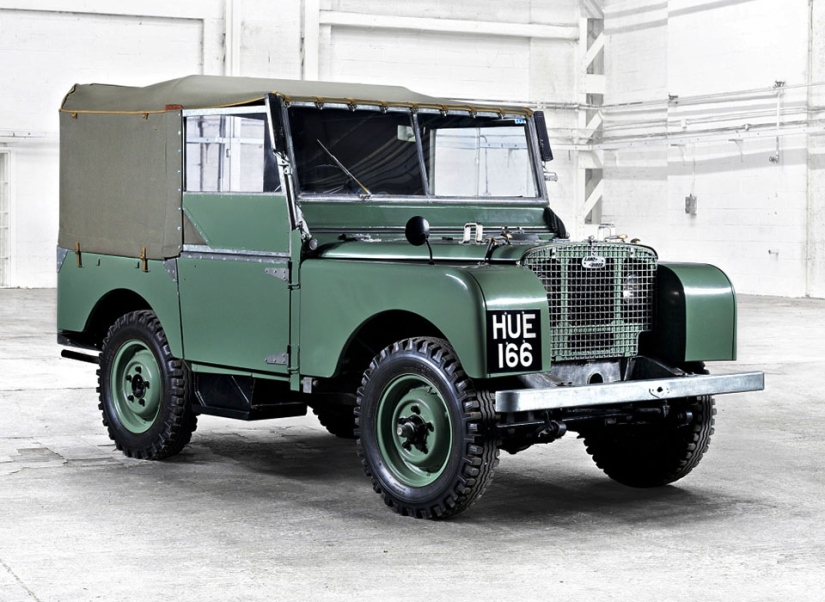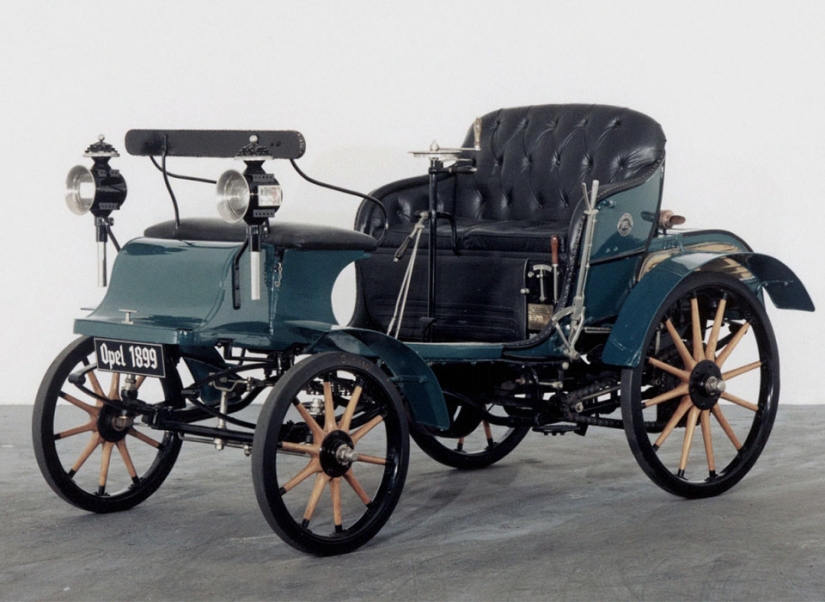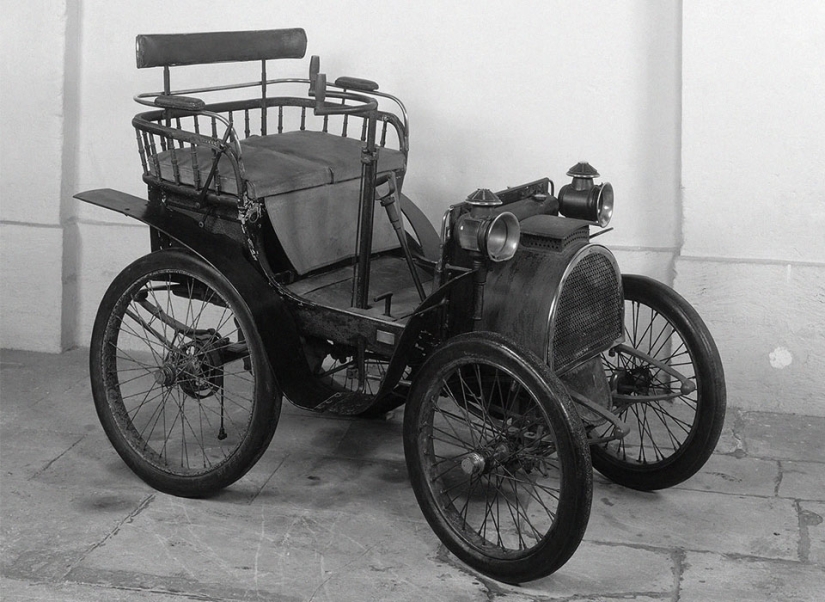Pioneers, which models did the history of automakers begin with
In every person's life, the first, uncertain step is always also the most important. With cars exactly the same parsley. Without the first unsophisticated, licensed BMW, there would have been no space i8; if Enzo Ferrari had not decided to build a 125S speedster, neither F40 nor LaFerrari would have happened later, and without the first FIAT, we might still be walking. We continue to remember the first cars in the history of the largest brands of our time.

This is the second and final part of the article about pioneer cars. As in the first issue, 20 cars were included in the material — from Land Rover to Volvo. The companies are listed in alphabetical order.

It all started with the fact that the "Rover" engineer Maurice Wilkes broke the army Willys Jeep, which faithfully served him on all kinds of household work. And you can't buy a new one! Then Maurice thought: why shouldn't Rover release its own SUV?
The first prototype was built on a Willis chassis, but with a gearbox and engine from the pre-war Rover P3. That car was famous primarily for the steering column located in the center of the cabin. Then the prototype "center-steer" evolved into a serial Land Rover Series 1, now living out the century in the guise of a "Defender".

Realizing that it was impossible to sell Toyota cars more expensive than Camry in the States, the Japanese decided to launch a new luxury brand in the US market. The first production Lexus is, in fact, a reshaped Toyota Celsior. But since this "luxobarge" has never been sold in the States, no one noticed the catch. On the contrary, an indecently huge amount of attention and popularity poured out on the brand's firstborn.

Unlike most modern brands, Maserati can be proud that its first car is a racing one. A typical two-seater car of the 1920s with a frame chassis, aluminum bodywork, an inline 1.5-liter "eight" and a three-speed manual transmission, the Maserati Tipo 26 debuted at the Targa Florio race of 1926. Alfieri Maserati, driving a car named after himself, rushed to the finish line first in class and ninth in absolute. Not bad for a start.

Strictly speaking, Mazda's first vehicle was a three-wheeled tuk-tuk. But if you consider a car to be something four-wheeled, with doors, roof and windshield, then this key car will be considered the first. The Mazda R360, in addition to its charming appearance and two-seater interior, was curious about the rear-engined layout and a 356 cc two-cylinder engine with a capacity of 16 horsepower. Yes, this is not an MX-5 — you can't drift on this…

A machine designed by Wilhelm Maybach and Paul Daimler, commissioned by Austrian entrepreneur Emil Jellinek, was named "Mercedes" in honor of the latter's daughter. And the enviable sporting and commercial success of the 35-horsepower car led to the fact that all subsequent Daimler Motoren Gesellschaft models also began to be called "Mercedes".

MINI appeared as an independent brand only in 2000 - forty years later than the original car, created by a Briton of Greek origin Alec Issigonis. Conceived as a response to European bubble cars - ultra—budget cars of the mid-50s — MINI has become a real symbol of the British automotive industry. Woven equally from both ingenious and contradictory decisions, he became a legend during his lifetime, having lasted on the assembly line for over four decades with minimal changes.

For Mitsubishi's huge industrial conglomerate, cars have always been a side business. Back in 1917, the shipbuilding company Mitsubishi Kobe Dockyard Works released a copy of the FIAT Tipo 3 rather out of curiosity. The car was not a commercial success in any case. Over the next four years, about 20 copies were collected, which no one really wanted to buy. After all , imported in Cars were cheaper to Japan from the USA and Europe.

The first car to receive the name "Nissan" is considered to be a copy of the American Graham Paige Special Six sedan. Its release in 1937 was established by the firm Jidosha Sezo Co ltd., owned by the Datsun group and renamed Nissan Motor by that time. From this tangle of indigestible facts, only one thing follows — no one else has a more confusing and intricate story than Nissan.

On the threshold of the XX century, the Opel family decided to expand its bicycle business at the expense of cars. Friedrich Lutzmann, an engineer and supplier of components for Daimler and Benz plants, was entrusted with the creation of the machine. However, the 1.5-liter crew developed by him for Opel did not enjoy success with buyers: 11 cars in the first year and less than 30 in the next. Opel did not renew the contract with Lutzman, and a few years later they released a car of their own design. More successful, by the way.

It's funny, but the first Peugeot car is called "Type 2". And it's not about the famous French sloppiness. It's just that the car, called the Peugeot Type 1, was actually steam—powered by the French designer Leon Serpollet. The first Peugeot with an internal combustion engine, the Type 2, appeared four years later and was essentially a licensed version of the German Daimler with a licensed Panhard & Levassor engine.

In the post-war devastation, the design bureau of Ferdinand Porsche, which moved from Germany to Austria, survived as best it could: highly qualified engineers did not disdain even repairing old agricultural machinery. But the hands of the masters, of course, missed the steering wheel. Ferdinand's son, Ferry Porsche, was especially restless. It was he who practically realized his father's pre-war dream with naked enthusiasm and built a light sports car based on a serial Beetle.
The first (and also the only) instance of the Porsche 356/1 was equipped with a roadster body made of aluminum, had a spatial frame and a complex mid-engine layout. The Porsche 356/2, which is less complicated in technical terms, went into the series, much closer in layout and design to the VW type 1.

The family business of making buttons did not excite Louis Renault at all — he was interested in cars. In a small workshop, Louis built a tiny machine on his own. Considering the wheelbase of only 1.1 meters, the name Voiturette, that is, "cart" or "cart", turned out to be the very point. With a deDion single-cylinder engine, Louis Renault's "cart", however, drove well. And after the car was shown on At the Paris Motor Show in June 1899, Renault immediately received 60 paid orders.

When Henry Royce, a wealthy industrialist from Manchester, who made a fortune in the production of port cranes, was tired of the breakdowns of his French Decauville car, he decided to act. Surely a self-driving carriage can't be more complicated than a port crane?!
Handy Henry took and built his own version of the "Decauville". Everything is the same in form and in fact, only a hundred times more reliable. It was on this two-cylinder 10-horsepower car that a rich Londoner, Charles Rolls, took a ride in May 1904. Well, every schoolboy knows what it led to today.

A well-known aviation company took up cars not from a good life. After the Second World War, orders for military aircraft came to naught, and the company from Trollhettana switched to more mundane mechanisms. It turned out not fast, but fun. Taking the pre-war DKW as a basis, the Swedes added a masterpiece aerodynamic bodywork by industrial designer Sixten Sason to the creatively rethought front-wheel drive chassis. The result was the appearance of an elegant and progressive SAAB 92.

Few brands can boast that their first car got into the presidential garage. However, in the case of Skoda, that's exactly what happened. The company's first passenger car is a licensed copy of the large, expensive and prestigious Hispano—Suiza-H6B. Czechoslovak President Tomas Masaryk, who traveled only by locally assembled cars, immediately ordered a 100-horsepower Skoda 25/100, which accelerated to 140 kilometers per hour without any problems. And I have never regretted it.

It is considered that the first car of the brand was the Subaru 360 key car, which debuted in 1958. If we are talking about serial models, so it is. But a few years before that, the Japanese had already tried to build cars. The rear-wheel drive Subaru 1500 sedan, also known by the code name P-1, was equipped with a Peugeot 202 engine, and outwardly suspiciously resembled another Peugeot sedan 403. In total, about two dozen "pe-firsts" were produced, some of which got into Japanese taxi companies to assess consumer qualities.

Looms, motorcycles, cars — the history of Suzuki has developed in this direction. The company's first passenger car, the Suzulight, is a copy of the German Lloyd LP400. Moreover, the similarity is not only external, but also layout-constructive: front-wheel drive, transverse motor arrangement, spine frame. Today, the original "Suzulite" is a real rarity, because only 43 copies of such machines were collected.

Toyota also started with looms, and developed the first passenger car — the A1 four—door sedan - in 1936. And there was absolutely nothing revolutionary in its design. The design of the car resembled the Chrysler Airflow, and the chassis and powertrain were neatly copied from Chevrolet. It was necessary to start somewhere.

Ferdinand Porsche was able to realize the dream of creating a mass car for ordinary hard workers only with the help of the Nazis, who authorized the development of a people's car and the construction of a factory. Dr. Porsche did his task perfectly. The ingeniously simple design with a ridge frame, a four-cylinder counterweight located in the rear overhang and a charming body has become synonymous with the concept of "A car for everyone". For all times.

In the early 1920s Assar Gabrielsson, an influential manager of the Swedish company SKF, specializing in bearings, worked in France. The Third Republic was experiencing a real boom in the auto industry, and at that time there was not a single more or less serious company in Sweden. "Disorder!" — said Gabrielsson and undertook to correct the situation.
Together with engineer Gustav Larrson and with funds borrowed from banks under personal guarantees, the Swedes developed and built 10 pre-production prototypes that became the basis of the first production Volvo OV4. By the way, OV4 literally means "Open body, 4-cylinder". Which, in principle, is not entirely true — out of ten prototypes, at least one had a fully enclosed body. Inconsistency…
Recent articles

Gerard Uferas is one of the most renowned and vibrant contemporary French photographers. His talent is multifaceted, but Uferas is ...

In 1969, a healthy food restaurant opened on the Sunset Strip in Los Angeles-one of the first in the country, and possibly in the ...

Colin and Kristin Poole are an amazing creative family. Colin is a world-renowned artist, and his wife Kristin is a wonderful ...